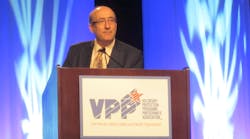Temporary workers are entitled to the same training and protection as full-time employees, OSHA Administrator David Michaels said during the opening general session of the 2014 National VPPPA Conference in National Harbor, Md.
That’s the theme of a new publication that OSHA and NIOSH unveiled Tuesday. The publication emphasizes that staffing agencies and their clients – “host employers” – are jointly responsible for providing safe and healthy working conditions for temporary employees.
“Staffing agencies and host employers together have to evaluate the work site, train staff to identify and eliminate potential safety and health hazards and implement the programs that are necessary to protect workers,” Michaels said during his VPPPA address.
The contract between a staffing agency and a host employer should define each temporary worker’s job tasks as well as each party’s safety and health responsibilities, Michaels said. OSHA and NIOSH also recommend that staffing agencies keep in touch with temporary workers to ensure that host employers fulfill their safety responsibilities.
“We [developed this document] because the employer’s commitment to the safety of temporary workers shouldn’t mirror those workers’ temporary status,” Michaels said Tuesday. “All workers in the United States have the right to safe work, and all employers have a duty to provide all workers with a workplace free of recognized serious hazards. It’s the law, and it’s the right thing to do.”
Michaels noted that the new publication is part of OSHA’s “concerted” effort to raise awareness of the need to protect temporary workers. The agency has stepped up its temp-safety enforcement, outreach and training, he said.
Michaels urged VPPPA attendees “to be the champions of these recommended practices.”
“You are the national leaders in protecting American workers,” Michaels said. “All of you get it. You know why you have to do this. Other employers will listen to you. You’ll be able to explain to them why it’s necessary to take extra steps to make sure that temporary workers are protected.”
Among the “great examples of VPP companies” that go the extra mile to protect their temporary workers, Michaels pointed to GE Healthcare’s Tower Avenue plant in Milwaukee, which provides the same level of safety training to temporary workers, contractors and permanent GE employees.
“All temporary workers and contractors performing construction work are required to complete an eight-hour safety orientation and pass a quiz to [demonstrate their understanding of safety procedures] before they start working on that site,” Michaels said.
Michaels added: “We want to see more programs like that.”
